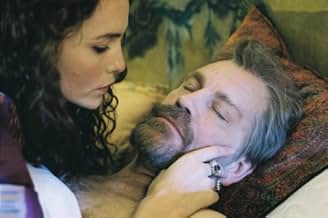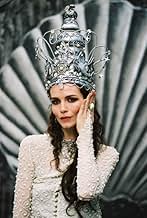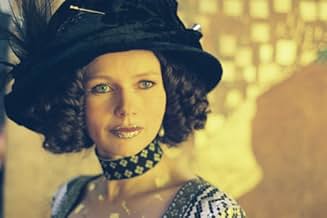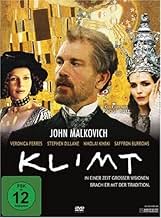Ajouter une intrigue dans votre langueA portrait of Austrian artist Gustav Klimt, whose lavish, sexual paintings came to symbolize the art nouveau style of the late nineteenth and early twentieth century.A portrait of Austrian artist Gustav Klimt, whose lavish, sexual paintings came to symbolize the art nouveau style of the late nineteenth and early twentieth century.A portrait of Austrian artist Gustav Klimt, whose lavish, sexual paintings came to symbolize the art nouveau style of the late nineteenth and early twentieth century.
- Réalisation
- Scénario
- Casting principal
- Récompenses
- 1 victoire et 4 nominations au total
Avis à la une
Hunter S. Thompson blew the journalistic world away by openly reporting events through the prism of his own drug-soaked experience. Terry Gilliam's cinematic portrayal of this in "Fear and Loathing in Las Vegas" conveyed this brilliantly.
So far as I know, Gustav Klimt did not portray his artistic vision in an ether-soaked stupor or in a state of syphilitic delirium. My problem with Mr. Ruiz portraying him as though he did is that Klimt actually led an exuberant revolutionary artistic movement in a city and continent exploding with creative energy, and this portrayal could hardly be farther from the truth. Even a non-linear poetic portrayal of the creative process should shed some truth on its essence.
The tone of the movie was static, suffocating, semi-conscious and joyless. Klimt's life was full of color, sexual experimentation and living life to its fullest, so it additionally seems odd that John Malkovich sleepwalks through his performance with less joy than Rod Steiger in "The Pawnbroker."
If Mr. Ruiz wanted to make a film about a fever-dream (Klimt died of pneumonia following a stroke, not of tertiary syphilis as suggested in the film), perhaps he should have entitled it "Fever-Dream: with a whimsical guest appearance by my fantasy of Gustav Klimt."
This film may be of use to film students to prove that images and sound do not automatically add up to a movie.
The movie is decorated with dozens of naked women who mainly parade about, or who try to seduce Klimt. Given that he is not particularly handsome, charming or intelligent, I failed to see the attraction. Perhaps it was just his fame as a painter.
The interiors and costumes are opulent turn of the century Vienna. Elaborate Viennese pastries tempt the eye. The sets are the main appeal of the movie.
There is a lot of cat and mouse dialogue where the characters reveal nothing and say nothing while attempting to sound profound. It is all quite frustrating.
Nikolai Kinski plays the homosexual painter Egon Schiele in an exaggeratedly swish way, reminiscent of Da'an's hand gestures in Earth Final Conflict.
The costumes and hair treatments are so elaborate, that I could not for the life of me tell the female characters apart. Is this a new character or an old one in a new do? The characters all behave the same way and look similar. I didn't develop any bond with any of the characters because I could not even tell them apart.
I can imagine that the reason many people didn't like this movie was because it's not what they expected.
If you want to see a straight forward, biographical accurate movie about the life of Gustav Klimt, then this movie isn't for you.
The basic premise is that Gustav Klimt is lying on his death bed and in a manner of flashbacks you get to see random scenes about a fictitious story revolving around a mysterious woman. Blinded by the fever, the scenes appear surreal and deliver a feeling similar to what you may feel upon viewing Klimt's artwork.
There's no straight plot following this movie and the real Klimt may not have been the way he appears in the movie, but that was never intended anyway. What this movie does is brilliantly deliver an atmosphere very fitting to the Wiener Moderne. The very important "Kaffeehaus Kultur" at the time, where intellectuals of Vienna spent the entire day in coffee houses is portrayed very precisely as well.
I also think that Malkovich and Nikolai Kinski seem to be a near perfect cast for Gustav Klimt and Egon Schiele.
Anyway, if you've read this review and get the feeling that this movie is not for you, then don't watch it. But if you're intrigued by what you've read then by all means, go see this movie!
Gustav Klimt (1862 - 1918) was a strange artist, a man who believed in a sensualist artificial religion and an artist who favored erotic imagery in his canvases. He was controversial in his time, yet today his paintings using gold leaf and silver leaf and design patterns of expression that defined Art Nouveau sell for many millions of dollars: his style is still imitated and he is still celebrated as the father of erotic art. The film opens and closes with Klimt (John Malkovich) submerged in healing waters in a rather stark hospital, attended by a nurse and his disciple, the equally sensational Egon Schiele (Nicolai Kinski, keeping his hands in the spread-finger style Schiele painted so often!). From this point bits and pieces of Klimt's bizarre life are explored, at times explained through imaginary conversations with his secretary (Stephen Dillane). His marriage, his 'affair' - or is it simply a manifestation of the influence of a muse? - with Lea de Castro (Saffron Burrows), his self indulgence in all things erotic (he is said to have has many affairs with Viennese women yielding a large number of children who bear his genetic puzzle), and his conflict with the Academy of Art, a sense of disgust with the current oeuvre of painting as sterile, and his prodigious output of paintings and drawing of the female nude - all are depicted with tremendous imagination here. The cinematography is as strange as the story it captures, using falling snowflakes in one scene to suggest the falling pieces of Klimt's gold leaf enhancement of his most famous works in others.
The dialogue is at times raw and at other times superficial and the audience is begged to indulge in the fantasy that is being recreated. But the film stands well as an example of an art history period and John Malkovich makes a credible Klimt. This is more a film for art students and art lovers who are eager to explore the beginnings of Art Nouveau than a film for audiences eager for accurate biography.
Grady Harp
Le saviez-vous
- AnecdotesRyan Phillippe was considered for the role of Klimt.
- GaffesWhen Klimt mashes the cake in the man's face, the icing on the man's face is not covering his right eye. In the next close-up shot, there is a large blob of icing covering the man's right eye. In the next long shot when Klimt starts to wipe the man's face, the icing is no longer covering the man's right eye again.
- Citations
Klimt: Who art thou Asked the guardian of the night From crystal purity I come Was my reply And great my thirst, Persephone Yet heeding thy decree I take to flight and turn, and turn again Forever right I spurn the pallid cypress tree Seek no refreshment at its sylvan spring but hasten on toward the rustling river of Mnemosyne Wherein I drink to sweet satiety And there, dipping my palms between The knots and loopings of its mazy stream I see again, as in a drowning swimmers dream All the strange sights I ever saw And even stranger sights no man has ever seen
- Versions alternativesA 131-minute-long Director's Cut was released theatrically in Austria and is available on DVD in the UK.
- ConnexionsReferenced in Ricardo Aronovich, avec mes yeux de dinosaure du cinéma (2011)
Meilleurs choix
- How long is Klimt?Alimenté par Alexa
Détails
- Date de sortie
- Pays d’origine
- Sites officiels
- Langues
- Aussi connu sous le nom de
- A Viennese Fantasy à la manière de Schnitzler
- Lieux de tournage
- Sociétés de production
- Voir plus de crédits d'entreprise sur IMDbPro
Box-office
- Montant brut aux États-Unis et au Canada
- 97 656 $US
- Week-end de sortie aux États-Unis et au Canada
- 2 332 $US
- 24 juin 2007
- Montant brut mondial
- 584 991 $US
- Durée
- 2h 11min(131 min)
- Couleur
- Mixage
- Rapport de forme
- 1.85 : 1




































